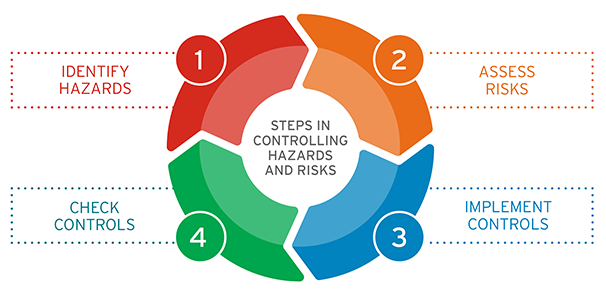Identify controls for hazards and risks from dust
Follow a risk management process to help you understand and manage dust hazards and risks from your business. You can learn how to follow a risk management process involving these steps:

Following a risk management process will also help you identify controls to put in place.
Put controls in place to manage risks from dust
Before you put controls in place, consider your approach to planning and site management.
For example, does your site layout help or hinder your control of hazards and risks? Do your business processes, systems and activities help you prevent harm?
The controls you put in place will depend on:
- your business activities
- the nature of the dust.
Preventing dust is the best approach to reducing risk. You should also:
- minimise dust. For example, use wind barriers and dust suppression measures
- manage dust. For example, use dust extractors and dust screens.
Before you choose a control, consider how you’ll use it and how effective it will be.
Controls need to be fit for purpose. Make sure you install and maintain them correctly.
You may also need to seek advice specific to you from a suitably qualified person. This might involve engaging a consultant.
Controls you can put in place to reduce dust include:
- completing your vehicle, plant and equipment maintenance
- air quality and dust monitoring, on and off site. This can include visual inspections, dust deposition and flux monitoring, and real-time PM10 continuous monitoring.
There are EPA publications to guide you in reducing the impact of dust:
- Erosion, sediment and dust: treatment train (publication 1893).
- Managing soil disturbance (publication 1894).
- Managing stockpiles (publication 1895).
- Working within or adjacent to waterways (publication 1896).
- Managing truck and other vehicle movement (publication 1897).
You can use other controls. But you must demonstrate you’ve eliminated or reduced the risk of harm as far as reasonably practicable.
Resources to help you manage risk from dust
These resources can also help build what we call your state of knowledge:
- Reducing risk in the premixed concrete industry (publication 1806)
- Civil construction, building and demolition guide (publication 1834)
- Dust containing crystalline silica in construction work
- Compliance Code – Excavation
- Compliance Code - Demolition
- Compliance code: Managing exposure to crystalline silica – engineered stone
- Working with engineered stone
- Stonemasons: Preventing crystalline silica exposure
- Dust containing crystalline silica in the extractive industry
- CMPA Dust Management Guideline
- A guideline for managing the impacts of dust and associated contaminants from land development sites, contaminated sites and remediation and other related activities
- Management of dust from development sites
- AS 2985 Workplace atmospheres – method for sampling and gravimetric determination of respirable dust
- AS 3640 Workplace atmospheres – method for sampling and gravimetric determination of inhalable dust
- AS 2985 Workplace atmospheres – method for sampling and gravimetric determination of respirable dust
Read next
Reviewed 4 May 2021



